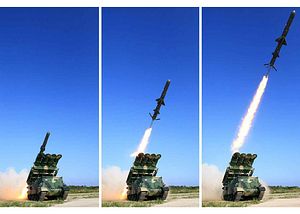On Friday, North Korea’s state-run Korean Central News Agency (KCNA) announced that it had tested a “new cruise rocket” system on Thursday morning. The country’s supreme leader, Kim Jong-un, presided over the launch, which took place from near Wonsan and featured multiple launches.
Released pictures of the event through North Korean state media confirm that the system tested on Thursday was first seen at the April 15 parade in Pyongyang, which commemorated North Korean founder Kim Il-sung’s 105th birth anniversary. Between the parade and Thursday’s launch, North Korea appears to have changed the system’s camouflage scheme from a naval-themed blue to regular forest camouflage.
The system is a new integrated coastal defense cruise missile (CDCM) launcher with four canisters for what may be an iterative improvement on the Kumsong-3, North Korea’s anti-ship cruise missile system that was first seen publicly in 2014 and is a variant of Russia’s Zvedza Kh-35 anti-ship cruise missile.
The KCNA statement touted that the new system, like the Pukkuksong-2 medium-range ballistic missile launcher first seen in February and the launcher for the new “ultra-precision” Scud short-range ballistic missile shown in late-May, uses a tracked transporter-erector-launcher. North Korea has made a point of showing off these types of launchers this year, all of which have been developed indigenously and increase the survivability of its various missile systems.
Notably, the tracked treads allow the launchers to shoot from unpaved roads or even entirely off-road, increasing the available space from which North Korea can operate these systems. (North Korea has just 724 km of paved roads compared to 24,830 km of unpaved roads across its entire territory.) Thursday’s launch, for the second time ever, features an off-road launch. (The first such launch was its second flight test of the Pukkuksong-2 in May.)
With the newly tested CDCM, this will be particularly important. In wartime, North Korea will be able to deploy this system as a “shoot-and-scoot” platform on its coasts, making it less likely that the launchers would be easily destroyed in either preemptive or retaliatory strikes. The advantage may be marginal against the superior capabilities of South Korea and the United States, but it represents a significant benefit over a similar point defense system or even a non-integrated mobile launcher.
Imagery of Thursday’s test released by Rodong Sinmun shows multiple CDCMs from the new launcher striking a target vessel parked off shore. Though it’s impossible to tell from the still imagery, KCNA claims that the test verified the cruise missile’s guidance features and the “ultra low cruise flight system.” North Korea should release video footage of the test soon.
As I noted in my analysis earlier today, with the successful test of its new CDCM, North Korea has shown off its fourth brand new system since February’s reveal of the Pukkuksong-2. That’s four systems in under four months, underlining both North Korea’s rapid missile force diversification and pace of development. (A theme also in its April 15 parade this year, which featured a range of new systems.)
Despite a few hiccups and failed tests, notably for the Hwasong-12 intermediate-range ballistic missile, Kim Jong-un has mostly witnessed early successes with his new suite of missiles. (The new CDCM’s launcher is new, but the projectile itself has been in North Korea’s possession for some time.)
The CDCM is designed to deliver a conventional high explosive payload and is likely capable of comfortably attacking small- to medium-warships. Its maximum range is likely similar to the Russian Kh-35 off which it is originally based, which would mean it is probably capable of hitting targets up to at least 150 kilometers away and perhaps further depending on specific improvements included in North Korea’s variant.
In November 2016, a modern Korean People’s Navy corvette was spotted by NK News with a Kumsong-3 launcher on board.
A cruise missile capability, paired with North Korea’s claimed surface-to-air missile capability with a system like the Pongae-5, which recently was declared to have reached initial operating capability, could form the foundation of a reasonable anti-access/area denial (A2/AD) posture for Pyongyang.
Much, however, would depend on how sophisticated North Korea’s intelligence, surveillance, and reconnaissance capabilities are. With its continued and steady testing of systems, however, Pyongyang continues to signal that it’s marching ahead with an ever-more-sophisticated and diversified missile force.

































